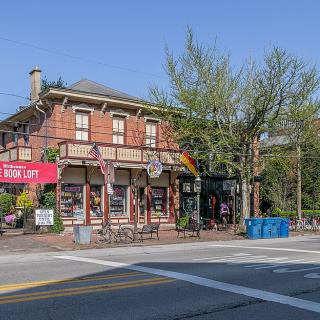Part One
The shame of the city
What happened to the University District?
The area adjacent to The Ohio State University in the middle of Columbus, Ohio, was once a distinctive, mixed neighborhood of owner-occupiers and their boarders and renters in small, scattered, private rooming houses and single-family homes. Over several decades it was transformed into the dominance—numerically, culturally, socially, politically, and economically—of large, for-profit landlords with young-adult student tenants. For 18 years I’ve been co-owner of a 107-year-old, architect-designed house in the district whose history partly reflects this transformation; it morphed from dual-family to multiple student renters and back to single-family status. The 2021-22 period crystalizes the 40-year history of this landmark neighborhood’s decline.
In violation of city zoning laws that regulated an area designated residential, corporate landlords and property managers often crudely converted distinctive homes. They also ignored building codes and safety laws by subdividing single- or dual-family homes into overflowing, profitable rental properties. The City provides no regular supervision, inspection, or regulation; it does not respond promptly, if at all, to complaints.
The unfounded myth of a “lost golden age” for the University District—a fall from an imagined, middle-class, homeowner’s mecca—ignores history and human actions. Contradictorily, that misleading myth is propagated by leaders of the University Area Commission, who failed to take any role in neighborhood preservation. (See Ellen Manovich, “‘Is This a Real Neighborhood’: Universities, Urban Development, and Neighborhood Change in the 20th Century United States,” unpub. Ph.D. Diss., University of Minnesota, 2016; “‘Time and Change Will Surely Show’: Contested Urban Development in Ohio State’s University District, 1920-2015,” Journal of Social History, 51, 2018, 1069-1099.)
Why did this occur? Major opportunities for collusion between the private sector that historically dominates the city of Columbus and its public institutions that contributed to massive neighborhood decline arose as normal neighborhood transformations—residential succession, in urban studies lexicon—were radically exacerbated and misdirected by official agencies of Columbus government. They aided and abetted inappropriate and illegal redevelopment. (See Kevin Cox, Boomtown Columbus: Ohio’s Sunbelt City and How Developers Got Their Way, Ohio State University Press, 2021.) This inseparably intertwined with the alternatively passive and active roles of Ohio State University. Ohio State, in turn, falsely presents itself as a “campus-area” steward while it cooperates with and profits from the avarice and mendacity of developers whom OSU supports, and who in turn donate to OSU. (See Graff, “Disconnecting Gown and Town: Campus Partners for Urban Community Development, Ohio State University,” forthcoming; “The decline of a once vital neighborhood: Columbus’ University District”; “Columbus’ University District: Students and the institutions that fail them.”)
How did this happen? Developers’ exemptions from the old City zoning regulations destroyed the University District through the common Columbus practice of granting them “variances.” To do this, the City ignored the written law, a. “process” eased and speeded by campaign contributions. At present, developers self-servingly demand charter code revision to make their profit-taking easier without having to request variances.
What are the indisputable consequences? The death of a neighborhood; the ruin of historic and historical properties, and one of the city’s older and most attractive areas. Especially with no district representative on City Council, this speaks to the failure of democratic city government and public institutions in Columbus. (See my “Is Columbus really a City?”; “Notes on current politics in Columbus and Ohio: Thoughts in response to questions from my editor”; and “Columbus city government is undemocratic and disorganized: It’s 2021 and we need a revolution.”)
It also speaks to the continuing contradictions of the “land grant mission” of one of the largest public universities in the nation with its origins in the dispossession of Indigenous Peoples’ land, segregation, and racism. (See my “The United States’ most disorganized university? Ohio State’s 5½ ‘D’s’: Disorganization, dysfunction, disengagement, depression, dishonest, and undisciplined,” forthcoming; and “For Ohio State, bigger is not better.”) “Campus Partners,” its “non-profit private development arm,” assists private developers in literally building a wall around the university. (See Graff, “Disconnecting Gown and Town.”)
This is a modern tragedy and scandal. It was not a “natural” or “inevitable” evolution. The story and its essential lessons are unknown, because Columbus lacks any tradition of self-study or ongoing research, historical or contemporary. OSU’s history department disdains local history, and the City does neither serious planning nor research or comparative study. Other cities and universities offer examples that Columbus ignores, from Minnesota to Pennsylvania and Chicago. (See Manovich, “‘Is This a Real Neighborhood’”; Graff, “Columbus’ identity crisis and its media”; “Columbus searches for its Downtown with historical, urbanist, and developers’ blinders”; and “Columbus, Ohio, searches to be a city: The myth of the Columbus Way.”)
The dark art of the deal, or is it the steal?
Not the only major player but one of the largest is Michael Stickney’s NorthSteppe Realty. Consider several revealing windows on NorthSteppe: It holds the dishonorable distinction of being lowest-rated in OSU’s annual student renter surveys (which are not publicized to the student body); having by far the largest volume of complaints across all indicators and media; being most often sued by present and past tenants; and owning properties in which student renters have died.
NorthSteppe Realty is neither transparent nor responsive. Past and present, its properties display flagrant disrepair; typically, the front door, windows, and doorbells are broken. Yards strewn with trash and illegal, obscene banners are common in football season: “F**k the [Oregon] Ducks,” “Maryland Girls Have the Crabs,” and “MILFs drink free.” In the most dramatic examples, one-half block from my home, four NorthSteppe properties are the sites of frequent parties with hundreds of drunken students, illegal tents and portable toilets without permits, and regular violations of the city noise and alcohol ordinances.
NorthSteppe properties’ residents are markedly uncivil to neighbors and authorities. They swear at older homeowners and tell reporters that we should “move to Upper Arlington” or wear earplugs to sleep. They generate a large volume of 311 complaints and Police Non-Emergency reports. When one or two police officers respond to complaints about large, out-of-control parties, they tell my neighbors and me that they are afraid to intervene. When we ask about back-up support, they actually laugh: not in the almost all-white, middle-class, college-student-dominated University District, unlike other parts of Columbus. CPD response is inconsistent at best, with responsible action unlikely. The 311 call center does not operate from 5:00 PM Friday through 8:00 AM Monday—the time of most violations.
Michael Stickney, his firm, his lawyers, and his tenants all agree: The law does not apply to them.
Stickney himself has donated at least $5 million to Ohio State University, although he is not an alumnus nor has he any institutional relationships. He sponsors senior administrators for membership in private social groups like the Columbus Club. Legally and ethically, this is a conflict of interest. In return, he is featured prominently on the university website as “OSU Student Housing”: It states, “NorthSteppe Realty is a full service commercial real estate firm specializing in providing Ohio State University housing....” On the contrary, he does not “provide Ohio State University housing.” Columbus city records do not allow research into other “donations,” but we can make educated guesses that OSU is not his only recipient. Along with his firm and lawyers, Stickney is personally unresponsive and regularly cancels meetings and appearances. He refuses to cooperate with either the City of Columbus’ or OSU’s efforts to regulate student rentals and student behavior. This violates numerous laws, in addition to ethical breaches.
NorthSteppe’s legal history is astonishing. A simple search reveals a steady pattern of illegal conduct since at least 2003, when fire broke out in an area house and killed five students, two from OSU and three visiting from Ohio University. It left another in critical condition.
NorthSteppe refused all responsibility, because the house contained smoke detectors and fire extinguishers. That does not address the cause of the fire or the fact that the house was due for inspection within a month. NorthSteppe’s long-time attorney immediately deflected attention to possible student behavior and away from structural issues and landlords’ legal responsibility. In his comments to the student newspaper The Lantern, lawyer Douglas Graff was much more concerned with rebuilding than with human losses. (See also, “Lawyer: Doomed Ohio Home Had Smoke Alarms.”)
Three years later in 2006, student renters sued NorthSteppe, claiming that the property owner committed fraud by intentionally hiding the cost of utilities. The landlords misled their tenants about the price of utilities, then billed them for hundreds of extra dollars when they moved out. The suit by students and their parents alleged fraud, negligent misrepresentation, and breach of contract. NorthSteppe and its lawyers refused to respond, their modus operandi. (See “OSU students suing landlord: Realty company intentionally hid utility cost, suit says”; “BigClassAction: NorthSteppe Realty”; “OSU students unite to sue realty company.”)
In 2014, 43 OSU students filed complaints about NorthSteppe. The student newspaper reported, “Many Ohio State students have come to expect some amount of decay when they move into an off-campus house.... But when the initial mold in the air conditioning and dirt on the floor turned into service requests that needed to be placed multiple times to be filled....” Add to this long-time broken window and “a stranger living in a room in their basement, unbeknownst to them....”
The reporter discovered that that NorthSteppe “accrued more than 220 housing violations between 2008 and April 2014. They ranged from cockroaches, owls, and rats to excessive trash, malfunctioning smoke detectors, lack of structural repair, unattached fire escape, and graffiti.” Little has changed in eight years.
An internet search quickly reveals a regular stream of complaints combined with strong warnings to potential renters. The condemnation of the firm and its personnel rings loudly off the page; for example, in this post on Reddit in 2020, the realty firm is “a bunch of assholes. They lie and cheat you out of things just for money, luckily my girlfriend calls them out on their bullshit in their main lobby and got a full refund on her move in a day.” In another: “This is why you don’t opt out of Student Legal Services when paying your fees. All you have to do is threaten to contact them and magically your landlord somehow starts getting shit done.” And “NorthSteppe is essentially a slumlord reality [sic] company, with limited options to live and all being expensive, they have basically not needed to make any renovations to their properties because someone will be late to the signing season and have to rent from them. What I don’t understand is how they are passing building and housing codes?” Indeed. I am told that Stickney was recently loudly called a “slumlord” by a fellow member at the Columbus Club.
The pattern is unwavering. Students are aware of these patterns, but NorthSteppe caters to fraternity members eager to relocate from those houses where OSU insists on moderate regulation of activity. NorthSteppe, by contrast, has allowed illegality and violations of neighbors’ legal and civil rights without penalty. Hundreds of OSU students have claims against landlords pending with overburdened Student Legal Aid for which they pay a premium along with tuition and fees.
That path continued in fall 2021, when a Columbus legal firm filed a class action lawsuit for regular failure to return full security deposits on time. The suit demands “that those countless students and others who rented from NorthSteppe over the last eight years and who had their Security Deposits wrongly debited be reimbursed in accordance with the double-damages provisions of the Ohio Landlord-Tenant Act.” As usual, neither Michael Stickney nor Doug Graff responded. The case remains unsettled.
In late January 2022, my neighbor, a University District homeowner for 25 years, and I filed a symbolic lawsuit in Small Claims Court against NorthSteppe because of the property owner’s and its tenants’ regular violation of our legal and civil rights, and damages to the neighborhood and physical and mental well-being. This is a first step pending a promised, long-overdue investigation by the City Attorney’s office.
Stickney and D. Graff and McGovern, his long-time malpractice lawyers—yes, that is the law firm’s specialty—show neither awareness nor respect for the law as written, nor civility or decency. In a failed effort at court-ordered telephone mediation with us, his lawyers first lied about NorthSteppe’s unresponsiveness and long-documented patterns of neglect and irresponsibility. They then asked questions about our use of any settlement funds. They have no legal right to ask that.
They then made it clear that they do not believe the law applies to them. Their principal statement to the almost absent Franklin County “mediator”: There are other party houses in the University District, and it’s a party district. The first comment is irrelevant; the second is factually untrue and insulting. Appearances and sounds to the contrary, the University District remains officially a residential area.
In face-to-face mediation a week later, attorney Douglas Graff bullied, interrupted, demeaned, mocked, insulted, and even parodied my co-claimant and me. He behaved like a preschooler and a caricature of an attorney in a bad 1940s movie. He showed no respect for long-term homeowners who are damaged by his client’s tenants and the client’s neglect. He referred to the informal, extra-legal conversation as “my courtroom” and asserted several times that “I'm the only lawyer here,” not only talking down to us but ignoring his associate seated beside him. He also attempted to silence his client whenever Stickney attempted to communicate with us. He loudly informed us, as if he were the magistrate, “You will lose this case.” I have filed a formal ethics complaint with the Columbus Bar Association.
In our lawsuit, we act not only for ourselves but for our 85-year-old neighbors, homeowners for more than 50 years; others with residential tenure in between; and many student renters who want the law to be enforced, their rights and well-being respected. If awarded the maximum of $6,000, we will transfer the funds to OSU Student Life’s now all-but-defunct Ambassador’s neighborhood trash collectors.
--------------------------------
Harvey J. Graff is Professor Emeritus of English and History and Ohio Eminent Scholar at The Ohio State University. He is the author of many books on social history. His Searching for Literacy: The Social and Intellectual Origins of Literacy Studies is forthcoming. His essays appear in Inside Higher Education, Times Higher Education, Washington Monthly, Academe, Publishers Weekly, Columbus Free Press, and other outlets. Specialties include the history and present condition of literacy and education including higher education, children and families, cities, interdisciplinarity, and contemporary politics, culture, and society



